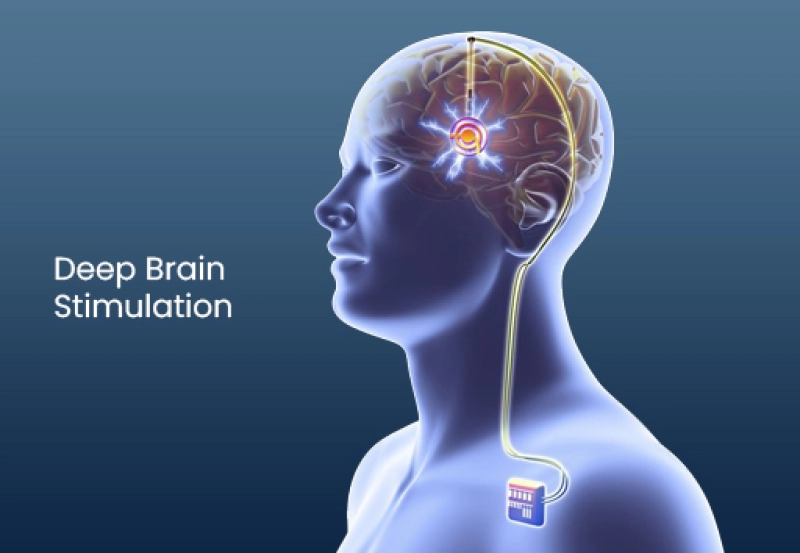

"Deep Brain Stimulation: Cutting-Edge Hope for Movement Disorders"
What is the "Deep Brain Stimulation Surgery"?
Deep Brain Stimulation (DBS) surgery is a type of neurosurgical procedure that involves implanting electrodes in specific areas of the brain. These electrodes are connected to a pulse generator, which delivers continuous electrical stimulation to these targeted areas. DBS is used primarily as a treatment for Parkinson's disease, but it has also been found to be effective in treating other neurological and movement disorders such as Essential Tremor, Head Tremor, Voice Tremor, Dystonia, Meige Syndrome and Tourette syndrome.
 How does DBS work?
How does DBS work?
The exact mechanism of how DBS works is not fully understood. However, it is believed that the electrical stimulation alters the abnormal activity in certain parts of the brain, which helps to improve motor function and reduce symptoms of movement disorders like tremor, rigidity and bradykinesia. It may also stimulate the production of certain neurotransmitters, such as dopamine, which are essential for proper movement and control in the body.
Who is a candidate for DBS?
DBS surgery is typically recommended for individuals who have not had success with medications or other traditional treatments for their movement disorder. Also Candidates for DBS surgery typically include individuals who experience significant side effects from medications used to treat movement disorders, such as dyskinesia (involuntary movements) or hallucinations. These side effects can not only affect the quality of life but may also limit the effectiveness of medication therapy, making DBS a viable alternative for those seeking relief from their symptoms.
DBS surgery, a sophisticated neurosurgical intervention, stands out as a revolutionary treatment for several movement disorders, notably including Parkinson's Disease, Dystonia, and various forms of tremor such as Holmes tremor, Dystonic tremor, head tremor, and voice tremor. This wide applicability underscores the procedure's potential to significantly enhance the quality of life for patients battling these challenging conditions. By targeting specific brain regions with electrical stimulation, DBS can alleviate symptoms such as rigidity, tremors, and involuntary movements, offering a new horizon of hope for individuals seeking improved mobility and independence.
The DBS Procedure
The DBS procedure consists of three main stages: the Preparation stage, the Electrode Implantation stage, and the Battery Implantation stage.
 Preparation Stage
Preparation Stage
Prior to the surgery, patients undergo a thorough evaluation encompassing neurological, neurosurgical, and psychological exams, as well as brain imaging tests such as MRI and CT scans, blood screenings, and psychological assessments. This preparatory phase helps in mapping out the specific brain areas to be targeted by DBS and in determining the patient’s overall fitness for the procedure. The success of Brain Stimulator Surgery hinges on precise patient selection and expert surgical techniques. Our focus is not merely on executing the procedure, but on identifying patients who genuinely require and will benefit from it. Therefore, our specialized team thoroughly assesses each patient's suitability for the surgery, particularly those dealing with movement disorders.
During the Preparation Stage, our patients also undergo detailed laboratory tests and a high-quality MRI scan under general anesthesia to clearly identify the target nuclei. The goal is to ensure the electrodes are positioned optimally to maximize benefits for the patient. This is because one of the secrets to a successful operation is the correct placement of the electrodes, a goal that heavily depends on the ability to clearly visualize all brain structures in the MRI imaging. This meticulous preparation ensures that we maximize the chances of surgical success by precisely targeting the areas that will benefit most from the DBS therapy.
Following the successful completion of these preliminary procedures, our patient is now fully prepared for the Deep Brain Stimulation (DBS) surgery. We are ready to proceed to the subsequent stages of the operation, where the expertise of our surgical team comes to the forefront, ensuring the precision and safety of this life-changing treatment.
Electrode Implantation Stage
During the Electrode Implantation Stage, under the focused care and patient-comfort-oriented approach, two small halls are created under local anesthesia, allowing for the placement of electrodes into the targeted brain area with millimetric precision. Our patient experiences no pain or discomfort during this process. Ensuring our patient's comfort, every possible precaution is taken, including the continuous presence of our translator to accompany the patient throughout the operation. Patients are allowed to have their phone, tablet, or computer with them. In critical cases, family members can be present at appropriate times to accompany the patient, ensuring a sense of security and comfort. The objective here is to make our patients feel safe and comfortable, aiming for them to remember this surgical process as a positive and enjoyable experience.
Before the permanent electrodes are implanted, a vital step involves placing temporary test electrodes to assess the electrical activity in the brain, along with providing test stimulations. This process is crucial as it allows us to determine which electrode placement will be most beneficial for our patient. The success of the surgery heavily relies on the precision with which these electrodes are positioned, as correct placement maximizes the therapeutic benefits the patient receives from the procedure. During this testing phase, we engage in a detailed consultation with the patient, asking them about their sensations and conducting several examinations. The primary reason for performing the initial phase of the surgery while the patient is awake is precisely this—to ensure the electrodes are placed in the optimal location for maximum benefit. Our goal extends beyond simply performing the surgery; we strive to carry out the procedure that provides the greatest advantage to our patient.
Position Verification Stage
After the Electrode Implantation Stage, we move to the Position Verification Stage. In this critical phase, we take our patient back to the imaging center for a follow-up CT scan. This step is essential for radiologically assessing the accuracy of the electrode placement. It's paramount that the electrodes are positioned precisely as planned, as this greatly influences the effectiveness of the DBS treatment. The CT scan provides us with a clear, detailed view, ensuring that the electrodes are correctly located within the targeted brain areas. Only after confirming their optimal placement do we proceed. Completing this stage successfully indicates we are ready to move forward to the final part of the procedure, the Battery Implantation Stage, where our patient returns to the operating room for the implantation of the neurostimulator, a device that powers the electrodes. This detailed validation process underscores our commitment to achieving the best possible outcomes for our patients, paving the way for a new chapter in their life, one marked by enhanced mobility and improved quality of life.
Battery Implantation Stage
Once the optimal placement of the electrodes is confirmed, a second surgery is performed under general anesthesia. In this procedure, a pulse generator (similar to a pacemaker) is implanted under the skin, under the collar bone. The generator is connected to the electrodes in the brain via insulated wires that run beneath the skin. This battery-powered device will continuously deliver the electrical impulses necessary for symptom control.
Upon the completion of these stages, all components are neatly tucked away under the skin, leaving no external equipment visible. This seamless integration ensures that patients can lead a relatively normal day-to-day life without the hassle of carrying external devices. The surgical intervention aims to be as minimally invasive as possible, prioritizing the patient's comfort and quality of life post-surgery. With the battery and electrodes securely in place, patients are set on a path towards managing their symptoms more effectively, opening up new possibilities for activities and engagements that were previously hindered by their condition.
While the surgical stages detailed above are typically carried out on the same day, the second phase of the surgery can be postponed to a later date if requested by the patient or if deemed necessary based on the patient's overall condition. This flexibility in scheduling is part of our commitment to patient-centered care, recognizing and accommodating the unique needs and preferences of each individual we serve. This approach ensures that each patient feels fully supported and comfortable with the process, further enhancing the effectiveness and positive outcomes of the Deep Brain Stimulation (DBS) treatment.
Advantages of Deep Brain Stimulation (DBS)
Deep Brain Stimulation (DBS) offers a beacon of hope for individuals grappling with debilitating neurological disorders. By utilizing cutting-edge technology, DBS provides a myriad of benefits that significantly enhance the quality of life for patients. One of its most compelling advantages is the considerable reduction of symptoms for conditions such as Parkinson's disease, essential tremor, and dystonia, among others, thereby allowing patients to reclaim independence and perform daily activities with ease. Additionally, DBS is adjustable and reversible; the stimulation settings can be tailored to each patient's evolving needs, and the procedure can be reversed if necessary, providing a level of flexibility and personalization unmatched by other treatments. Furthermore, for many patients, DBS has been shown to reduce the reliance on medication, thereby minimizing the side effects associated with pharmacological treatments. This innovative surgical therapy embodies a significant step forward in neurology, offering not just symptom relief but a renewed sense of hope for a better, more active life.
Longevity and Maintenance of DBS Devices
One of the notable advancements in Deep Brain Stimulation (DBS) technology is the availability of rechargeable battery options, which can extend the device's lifespan to 15-20 years. This development significantly reduces the frequency of surgical interventions for battery replacements, thereby minimizing the patient's exposure to procedural risks and discomfort. Additionally, when a battery replacement becomes necessary, it can be conveniently performed under local anesthesia. This ensures a quicker recovery time and a more comfortable experience for the patient, further emphasizing the patient-centric approach of DBS therapy. The integration of rechargeable batteries not only enhances the convenience and safety of the treatment but also contributes to a sustainable long-term solution for managing chronic neurological conditions.
What Are the Risks of Deep Brain Stimulation Surgery?
Despite the promising benefits and advancements in Deep Brain Stimulation (DBS) technology, it is essential for patients and their families to be aware of the potential risks associated with the procedure. Like any surgical intervention, DBS surgery carries the risk of complications, such as infection, bleeding, and the need for additional surgeries to adjust or replace parts of the system, If the electrodes are not positioned correctly... There's also a potential risk of stroke or brain hemorrhage, though such occurrences are very rare.
Let's delve into the details of these risks and clarify how we are working to reduce their occurrence rate.
Risk of Bleeding
The risk of bleeding arises because the electrodes are inserted into the brain through a small opening, which could potentially intersect with vascular structures. To mitigate this risk, we conduct an MRI under general anesthesia, during which a contrast agent is administered intravenously. This allows us to visualize the entire vascular network of the patient's brain. With these images, we ensure that we are not encroaching upon any blood vessels as we advance towards our target. Our systems work with precision down to a tenth of a millimeter, ensuring that MRIs taken with contrast greatly minimize the risk of bleeding to a very low level.
Risk of Infection
Infection is a risk inherent to all surgical interventions, but it becomes exceedingly rare when an experienced surgical team employs the correct techniques and utilizes the most technologically advanced equipment. Our center specializes exclusively in Neuromodulation surgeries, and every member of our team is dedicated solely to assisting in these types of operations. Additionally, maximum attention is paid to sterility throughout the surgery, and post-operative care includes the administration of highly effective, strong antibiotics, daily wound care performed by our team, and even the sutures are placed by our leading surgeon. Thanks to these techniques and protective measures, the risk of infection remains below that reported in the scientific literature.
Risk of Incorrect Electrode Placement

The risk of incorrect electrode placement in Deep Brain Stimulation (DBS) surgery cannot be overstated, as the location of electrode implantation directly influences the degree of benefit a patient can derive from the procedure. An electrode placed inaccurately can result in minimal or no improvement in the patient's condition and may even cause undesirable side effects. To mitigate this risk, we utilize highly advanced MRI techniques with top-quality imaging software under general anesthesia to ensure the clarity and precision required for accurate electrode placement. Another crucial aspect of ensuring electrode placement accuracy is through intraoperative testing, where multiple test electrodes are inserted into both sides of the brain. During this phase, we closely monitor the brain's electrophysiological activity and conduct awake patient examinations by sending test signals. This practice allows us to confirm the effectiveness of the target area for each patient. Additionally, we employ a post-operative CT scan to radiologically verify the accurate placement of electrodes after the surgical sites are closed. These meticulous techniques help us prevent incorrect electrode placements, thereby maximizing the patient's potential benefits from the DBS surgery.
All of the risks mentioned above are significantly rare when the surgery is performed by an experienced team. Ensuring that patients receive care from surgeons and medical personnel who specialize in Deep Brain Stimulation and utilize the latest technological advancements not only minimizes these risks but also ensures the highest standards of patient safety and care. Our commitment to excellence in DBS therapy is reflected in our continuous effort to refine surgical techniques, implement the most advanced imaging technologies, and provide comprehensive post-operative support to each patient. This approach has been instrumental in maintaining our complication rates well below the national averages reported in scientific literature, reinforcing our position as a leader in the field of neurosurgical patient care. With our patient-centric approach and commitment to safety, we strive to provide the best possible outcomes for patients seeking relief from chronic neurological conditions. So if you or a loved one is considering Deep Brain Stimulation as a treatment option, rest assured that with us, your safety and well-being are our top priorities. So don't hesitate to reach out to us for more information or to schedule a consultation. Together, we can work towards a better quality of life for those struggling with chronic neurological conditions.
Remember, at DBS Therapy Center, our expertise and compassion go hand in hand to provide you with the best care possible. Thank you for choosing us as your partner on this journey towards improved health and well-being. We look forward to helping you take control of your life with our advanced Deep Brain Stimulation technology.
last edited on 15.07.2024